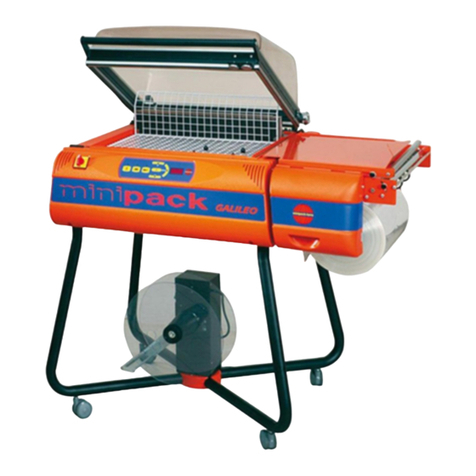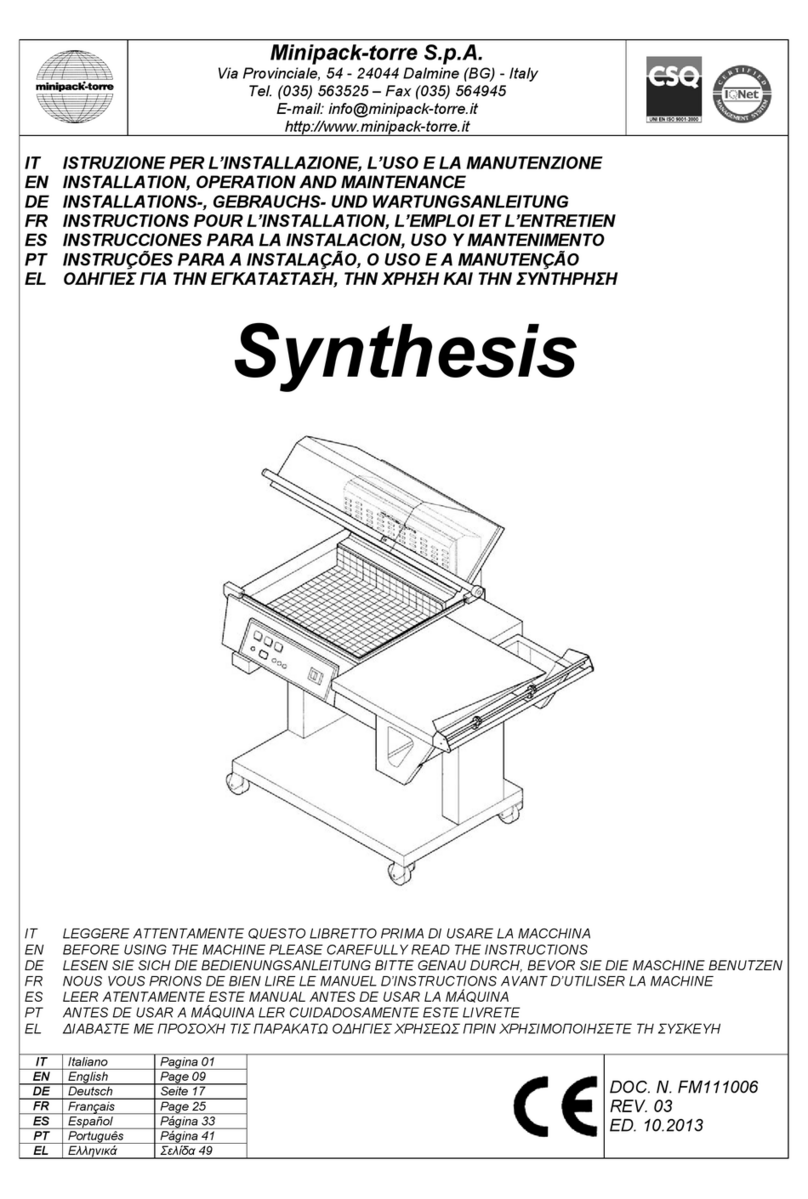
5
Capitolo 3. Regolazione ed approntamento macchina ITA
3.2. Inserimento bobina film
!Inserire la bobina di film sul rullo (6) bloccandola mediante i coni centratori (7) (figura 3.2. pag.59).
!Posizionare il rullo sul supporto bobina.
!Passaggio attraverso i microforatori (8).
!Passaggio del lembo inferiore del film sotto il piatto di confezionamento (9).
!Passaggio del lembo superiore del film sopra il piatto di confezionamento (9).
3.3. Posizionamento del piatto retinato
Il piatto retinato (11) può essere posizionato a seconda dell’oggetto da confezionare.
Per il suo posizionamento agire come segue (figura 3.3. pag.59):
!Tirare il piatto secondo le frecce
!Rimuovere il piatto dai riscontri
!Riposizionare il piatto sui riscontri all’altezza desiderata
N.B.: Per una buona confezione il piatto retinato deve essere posizionato in modo che la saldatura del film si trovi a metà
dell’altezza della confezione.
3.4. Regolazione supporto bobina e piatto di confezionamento
Il supporto bobina (5) e il piatto di confezionamento (9) devono essere regolati in funzione della larghezza (a)
dell’oggetto da confezionare, lasciando circa 1-2 cm di spazio tra l’oggetto ed il bordo di saldatura (figura 3.4. pag.59).
3.5. Esecuzione 1^ saldatura film
Per eseguire la 1^ saldatura portare il film come indicato in figura (figura 3.5. pag.59). Abbassare la maniglia della
campana con la mano sinistra e premere con una pressione di 10-15 Kg. La macchina entrerà automaticamente in
funzione e realizzerete la 1^ saldatura sul lato sinistro del film. Con la mano destra aiutate il distacco del film dalla lama saldante.
3.6. Aggancio film all’avvolgitore
Eseguire ora un numero di cicli sufficente a formare una striscia di film di scarto (figura 3.6.A pag.59).
Passarla intorno ai rullini di rinvio (26) e (27), al rullino di comando (28) ed agganciarla all’avvolgitore (29) (figura 3.6.B
pag.59). Ora la macchina è pronta per procedere al confezionamento.
3.7. Introduzione dell’oggetto da confezionare
Sollevare con la mano sinistra il bordo del film sul piatto di confezionamento. Introdurre con la mano destra il prodotto nel
film e farlo scorrere verso sinistra fino a depositarlo sul piatto retinato lasciando circa 1-2 cm di spazio tra il prodotto ed il
telaio interno di saldatura in modo da permettere il passaggio dell’aria per la termoretrazione (figura 3.7. pag.59).
3.8. Confezionamento
Premendo sulla maniglia della campana con una pressione di circa 15 Kg. questa va ad appoggiarsi sulla lama saldante
(figura 3.8. pag.60). In questo modo avviene automaticamente la saldatura del film sui lati aperti (destro e di fronte).
Se avete selezionato la funzione “SALDATURA + RETRAZIONE” vedrete il film retrarsi attorno al prodotto, diminuite
allora leggermente la pressione sulla maniglia della campana in modo da permettere lo stacco del film dalla zona di
saldatura all’interno. Con la mano destra aiutate il distacco del film dalle lame saldanti verso l’esterno.
Capitolo 4. Limitazioni e condizioni d’uso della macchina ITA
4.1. Dimensioni max. della confezione
FM75 Digit a = mm 400 b = mm 250 c = mm 200 (figura 4.1. pag.60).
FM76 Digit a = mm 500 b = mm 380 c = mm 250 (figura 4.1. pag.60).
N.B.: le misure indicate nella tabella si riferiscono alla misura max. della singola dimensione.
Per la misura max della confezione (b x c) bisogna comunque fare riferimento al capitolo 5.2., dove si vede che, la
somma di (b + c) é comunque uguale alla larghezza della bobina del film meno 100 mm.
4.2. Ciò che non si deve confezionare
E’ assolutamente vietato confezionare i seguenti tipi di prodotti per evitare di danneggiare in modo permanente la
macchina, oltre che provocare rischi di infortuni all’operatore addetto:
•Prodotti bagnati e instabili
•Liquidi di qualsiasi tipo e densità in contenitori fragili
•Materiali infiammabili ed esplosivi
•Bombolette con gas a pressione o di qualsiasi tipo
•Polveri sciolte e volatili
•Materiali sciolti con dimensioni più’ piccole dei fori del piatto retinato
•Eventuali materiali e prodotti non previsti che possano in qualche modo essere pericolosi per
l’utente e provocare danni alla macchina stessa





























